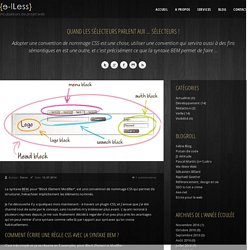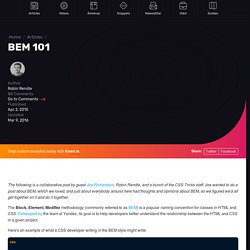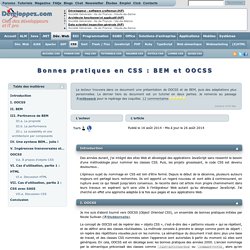

CSS Formatting. Ronan Levesque – Nommage et architecture CSS. BEM. BEM — Block Element Modifier. CSS Naming Conventions that Will Save You Hours of Debugging. BEM CSS How to apply BEM to your classes (CSS Tutorial 2/2) What is BEM CSS and how to use it (CSS Tutorial 1/2) "MindBEMding – Rethink Web Development" - Presentation By Kevin Mack.
Introduction to BEM - A front-end methodology. OOCSS, ACSS, BEM, SMACSS: what are they? What should I use? – clubmate.fi. The way we write CSS has changed a lot in last few years, and the abbreviation jungle gets deeper and deeper.

Heres a list of links to influential articles and quick summaries of these techniques. update: 2014.01.23 rewrote the Atomic and the BEM sections. I think there have bee happening big things in how we write CSS, for a reason I suppose. The will to make CSS more modular is strong (to make CSS so that it’s easier to control without breaking everything when you change a small thing). Object Oriented CSS (OOCSS) In a nutshell: Keep the structure and skin separate Keep the visuality separate, so you can reuse the visual classes. Separate container and content “rarely use location-dependent styles.” Ul li.list-item { ...} Go straight into the element: .list-item { ...} More reading on the subject: Atomic approach Science joke time: Why can’t you trust atoms? Now, Atomic can mean a few things: Atomic Design More reading: Atomic Design.
Organizing CSS with OOCSS, SMACSS, and BEM - Matt Stauffer. Writing Modular CSS With Sass and BEM. CSS Architecture Block-Element-Modifier (BEM) - SitePoint. The following is an extract from our book, CSS Master, written by Tiffany Brown.

Copies are sold in stores worldwide, or you can buy it in ebook form here. BEM, or Block-Element-Modifier, is a methodology, a naming system, and a suite of related tools. Created at Yandex, BEM was designed for rapid development by sizable development teams. In this section, we’ll focus on the concept and the naming system. BEM methodology encourages designers and developers to think of a website as a collection of reusable component blocks that can be mixed and matched to create interfaces.
Figure 2.3. Blocks can contain other blocks. Figure 2.4. Syntaxe BEM : convention de nommage CSS. Auteur : SteveDate: 12-07-2014 La syntaxe BEM, pour "Block Element Modifier", est une convention de nommage CSS qui permet de structurer, hiérachiser implicitement les éléments nommés.

Je l'ai découverte il y a quelques mois maintenant - à travers un plugin CSS, et j'avoue que j'ai été charmé tout de suite par le concept, sans toutefois m'y intéresser plus avant. L'ayant recroisé à plusieurs reprises depuis, je me suis finalement décidé à regarder d'un peu plus près les avantages qu'on peut retirer d'une syntaxe comme celle-là par rapport aux syntaxes qu'on croise habituellement. Comment écrire une règle CSS avec la syntaxe BEM ? BEM 101. Share this: Ship custom analytics today with Keen.io.

The following is a collaborative post by guest Joe Richardson, Robin Rendle, and a bunch of the CSS-Tricks staff. Joe wanted to do a post about BEM, which we loved, and just about everybody around here had thoughts and opinions about BEM, so we figured we'd all get together on it and do it together. An Introduction to the BEM Methodology. Let’s face it, we all want to make our code easier to read.

Doing so helps us work more quickly and efficiently, and when others work with us we can maintain clarity and coherent semantics. These days there seem to be so many standards and terms in the CSS world: OOCSS, SMACSS, BEM and more! These are all approaches for improving CSS structure, and today we are going to cover BEM. BEM stands for Block Element Modifier. It suggests a structured way of naming your classes, based on properties of the element in question. The block is the container or context where the element finds itself. The block element forms the root of the class and will always go first.
The element is the piece of a block. ‘Why BEM?’ for CSS in a nutshell. A New Front-End Methodology: BEM. This article is the sixth in our new series that introduces the latest, useful and freely available tools and techniques, developed and released by active members of the Web design community.

The first article covered PrefixFree1; the second introduced Foundation2, a responsive framework; the third presented Sisyphus.js3, a library for Gmail-like client-side drafts, the fourth shared with us a free plugin called GuideGuide4 and the fifth presented Erskine Design’s responsive grid generator Gridpak5. Today, we are happy to feature a toolkit devised by Yandex: BEM. BEM stands for “Block”, “Element”, “Modifier”. It is a front-end methodology: a new way of thinking when developing Web interfaces. This article will elaborate on the theory as well as the practice of building websites at Yandex—one of the leading internet companies in Russia. Due to the length of this article, it was split into three parts: A New Front-End Methodology: BEM (Blocks Reiteration) By Varvara Stepanova.

Ronan Levesque – CSS et notation BEM. Bonnes pratiques en CSS : BEM et OOCSS. Des années durant, j'ai intégré des sites Web et développé des applications JavaScript sans ressentir le besoin d'une méthodologie pour nommer les classes CSS.

Puis, les projets grossissant, le code CSS est devenu douloureux… L'épineux sujet du nommage en CSS est loin d'être fermé. Depuis le début de la décennie, plusieurs auteurs majeurs ont partagé leurs recherches. Ils ont apporté un regard nouveau et sont allés à contrecourant, en rupture avec ce qui faisait jusqu'alors consensus. Je raconte dans cet article mon propre cheminement dans leurs travaux en espérant qu'il sera utile à l'intégrateur Web autant qu'au développeur JavaScript.
Bonnes pratiques en CSS : BEM et OOCSS. Des années durant, j'ai intégré des sites Web et développé des applications JavaScript sans ressentir le besoin d'une méthodologie pour nommer les classes CSS.

Puis, les projets grossissant, le code CSS est devenu douloureux… L'épineux sujet du nommage en CSS est loin d'être fermé. Depuis le début de la décennie, plusieurs auteurs majeurs ont partagé leurs recherches. Ils ont apporté un regard nouveau et sont allés à contrecourant, en rupture avec ce qui faisait jusqu'alors consensus. Je raconte dans cet article mon propre cheminement dans leurs travaux en espérant qu'il sera utile à l'intégrateur Web autant qu'au développeur JavaScript. Sommaire. Application de la méthodologie BEM dans le développement HTML/CSS, quelle drôle d’idée ! - ekino. Introduction Vendredi 13 juin, à l’occasion de la Kiwi Party qui s’est déroulée à Strasbourg, Thomas Zilliox nous a présenté la méthodologie BEM et les différentes manières de l’appliquer à nos projets.

Une occasion pour nous d’approfondir cette méthodeet de voir dans quelle mesure elle peut simplifier notre façon de travailler en équipe. Conseils et bonnes pratiques. Accueil → La plupart du temps, j'utilise simplement des classes délimités par des traits d'union (ex. .foo-bar, pas .foo_bar ou .FooBar), mais dans certaines circonstances, j'utilise la notation BEM (Block, Élément, Modifieur).
Petite définition de BEM. BEM n'est ni une marque de voiture ni un groupe de musique, et encore moins une onomatopée (quoique). C'est plutôt une façon de nommer les classes en CSS, une convention en d'autres termes voire une méthodologie. Dans cet article, je ne vous expliquerai pas pourquoi il faut préférer BEM à une autre convention, je vous explique surtout comment l'utiliser. BEM — Block Element Modifier.